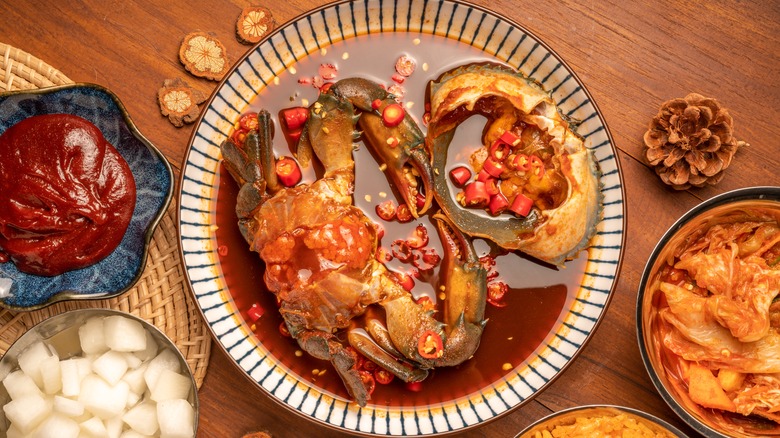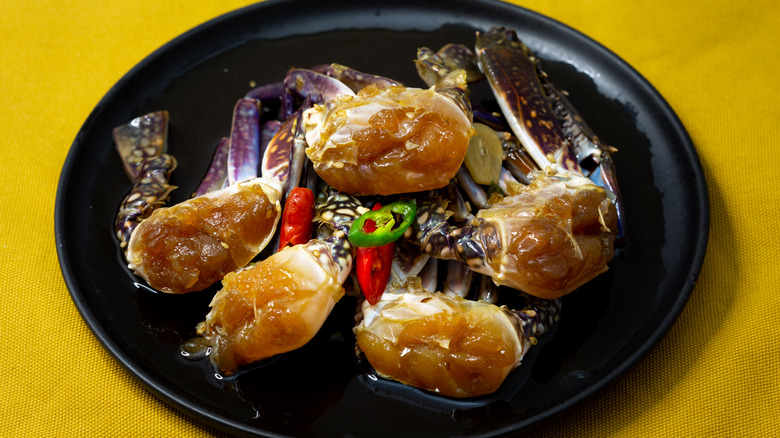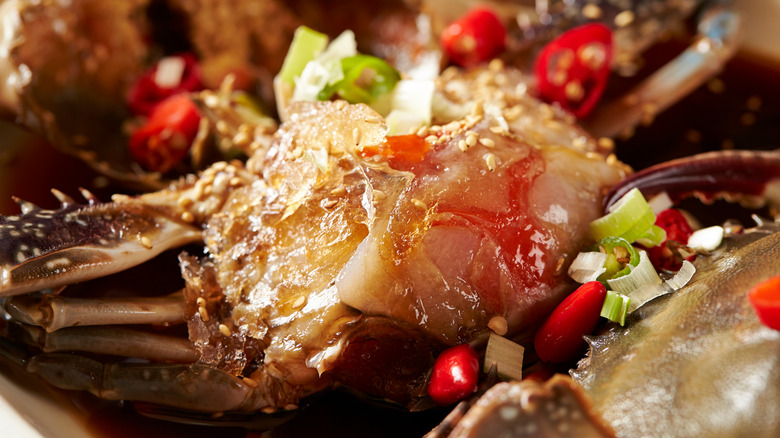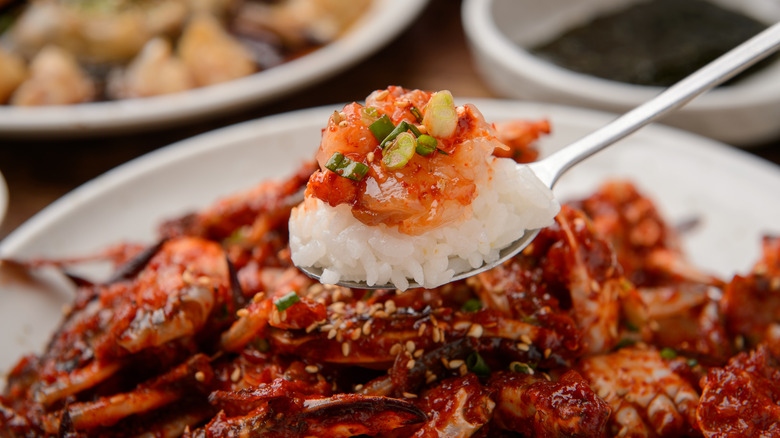Gejang Is Korea's Crab And Sauce Dish You Should Know About
Korean cuisine enthralls with its methods of preservation and can kick off a dinner with its medley of pickled and fermented veggies that are known as banchan. However, kimchi is just the tip of the iceberg — even crustaceans are subject to marination.
Take gejang, a dish made with live crabs doused in a soy-sauce-based marinade. Traditionally, the critters are stacked in a large container, while the flavor-dense sauce is recycled over the container for several weeks. The result is a delicious seafood dish perfect to pair with rice. No wonder gejang is affectionately referred to as "rice thief," which plays on the idea that "one does not realize how much rice they are eating" because of the savoriness from the crab meat, a sweet-salty sauce, and occasionally a morsel of roe (via Michelin Guide).
And while nothing beats digging in at a Korean restaurant dedicated to gejang, it can be prepared at home, too. When blessed with fresh crabs, it's one of the best recipes to highlight their sweet flavor. Such a reverence to the crustacean is exactly how the dish came about.
Origins and consumption of gejang
As with other fermented Korean foods, gejang arose as a preservation method. It was consumed from at least the 17th century and was first crafted with a freshwater species called Chinese mitten crab. The crab would be fermented in soy sauce for several months to enhance flavor, which was a duration long enough to break into its shell. Such a rendition was considered a delicacy and even served in the royal court. Gejang then adapted to other crab species and marinades like rice wine, vinegar, and saltwater.
Today, the dish reaches for saltwater crabs and a short fermentation time, and new flavorings have emerged, like the spicy, pepper-based yangnyeom. Many use freezers to aid in preserving freshness as well. Nevertheless, gejang is seasonal, exclusively enjoyed during two distinct periods come summer and fall. During this time, it's popular in restaurants dedicated specifically to gejang preparation, as well as inside the home.
Ingredients utilized in gejang
Most renditions of gejang are formed atop a soy sauce-based marinade, which is is flavored with sweet apple, onion, ginger, garlic, and dried kelp. Chili peppers are a common addition — in Korea, it's typically a long green variant known as cheong-gochu, reminiscent of a jalapeño. Many versions also include dried red chilies.
There are a few deviations in the marinade's flavorings — some add rice syrup, while others use brown or white sugar as a sweetener. Flavorings like citrus slices and bay leaf are also common. The aim is to create a savory, balanced infusion that will align with the flavor of the crab, and everyone has their own approach.
When it comes to the crustacean itself, blue crab is the popular go-to stateside. In Korea, horse crab and Asian paddle crab are most common. And to round out gejang's components, white rice is a staple to serve along with it to soak in the delicious flavor of the crab and marinade.
How gejang is prepared and eaten
Marinade assembly is initiated by combining all the components with water and bringing to a boil. The liquid is simmered for around 15-20 minutes, allowing the ingredients to mesh together. It's then strained and allowed to cool.
Meanwhile, the crabs are cleaned, and after thorough washing, the antenna, gills, and other spiny parts are removed. The shell is cracked open so that flavors can infuse inside. Any crab roe and tomalley found inside are kept intact as these substances add to the flavor. Next, the creatures are placed into sealable containers, like a large mason jar, with the bellies facing up. The marinade is poured inside, and the mixture is fermented for 24 hours in the fridge.
To serve gejang, the crabs are broken into pieces using shears and laid onto a plate. Some of the marinade is poured on top and optionally garnished with green onion, peppers, and sesame seeds. The meat is carefully taken out from claws and legs, while rice is spooned into the shell to sop up the delicious sauce.



